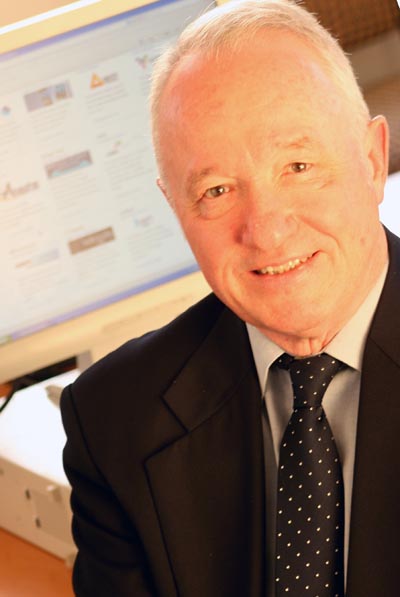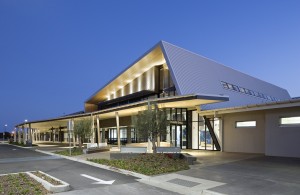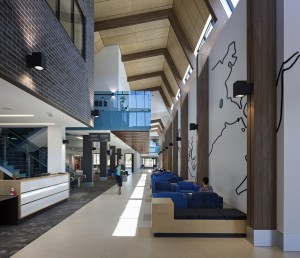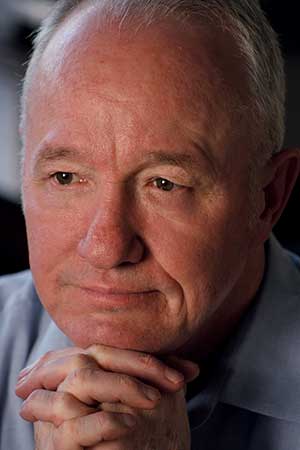THE DIGITAL revolution is probably one of the only major revolutions most of us have ever seen. The drivers and causes are not easy to understand for most people, but the impacts are clear to all … ever increasing connection, communication, information and collaboration at the touch of a button.
We have never been more connected.
The industrial revolution is long gone, though its signature factories, railways and chimneys are still with us today. It had a profound effect on the way our societies are organised, and the nature of jobs that individuals perform. 
We have spent the last century refining our systems, training, education and management … just in time for that to be undermined and disrupted by a new digital revolution with characteristics that take us into the future and back to the past at the same time.
On the one hand, back to the closeness of the village, but this time a new ‘global village’ with no boundaries, or commonly agreed rules and regulations.
And on the other hand, forward into a multiverse of technology connectivity that externalises our senses and nervous system and connects us to others, to information, ideas and automation never dreamed of in Wilmington, Kent where I grew up.
Factories, chimneys, machines, smoke, steam and furnaces are hard to miss and we are still living with their industrial impacts on our environment. Digital is a different matter.
It is largely invisible. The major currents of the digital revolution driving the change are ever more connection, more collaboration and more integration.
And the more, becomes even more every single day.
As a result, innovation is supercharged and the tools of the revolution are relatively cheap, easier to use all the time, and in the hands of imaginative and agile users who are very disruptive to existing business models, sectors and systems.
Software development is simpler than ever in an open system and open source world. Problems and issues are identified and attacked by thousands of individuals across the planet, and the results shared to build even better tools.
Most of this activity happens in bedrooms, home offices, cafes, libraries and first floor offices in back streets, industrial estates and above shops, not just in Silicon Valley or the Washington beltway.
New products and services are launched and fail. But the cost of failure is low and the learnings are huge. And the agile move on with new ideas, into new fertile relationships and new opportunities.
And that is a problem for establishments of all kinds, whether corporate, government or otherwise, because the disruptive levers are more accessible than ever before and the impacts of these levers can become widespread without reference to the world that was.
This is a paradigm shift. Power is moving from the top to the bottom of society. Power is shifting from the ‘vendor’ to the customer. Power is shifting from the few to the many. Power is being shared.
These underlying shifts are slow but remorseless.
As in the industrial revolution, some major impacts can take decades or longer to demonstrate real effect. But there is an almost constant daily stream of minor digital impacts that captures media attention and hides the real disruptive change. There is a lot going on below the media radar. And the collective effects of all that activity are what really causes the revolution.
Meanwhile, in the old world, the established businesses and industries continue with business as usual. They are aware that something is happening. They can see it in their research, customer comments, and general conversations. But they don’t quite know what.
They are like frogs in a well. They have deep knowledge of the old world environment they operate in but only a small view of the big new digital sky.
There are whispers and rumours but CEOs and management teams don’t change what they are doing for whispers and rumours. Many don’t even believe that anything significant or important is really happening. So they talk to colleagues.
More frogs. More wells.
Big mistake.
The big guys talk to other big guys. They control and manage hundreds or even thousands of employees so they must know something, right?
Of course.
They know how to succeed in the old world. That is why they grew so big and successful in the first place, and managed to maintain their position.
Big frogs in deep wells.
But they actually don’t know where to go to get advice about the new world, because the people who could tell them are already planning to eat their lunch.
And they aren’t going to warn them. They are just going to nibble as much share as possible from the toes and legs of the big corporates before they react and try to fight back. Which they will … and they do.
There is always a strong reaction. Shareholders demand it. But that model is broken as well. And it only slows decline and fall, it doesn’t stop it, because, the reaction is just that … a reaction. There is no real insight. No focus. No strategy. No exit.
Think Sensis and Yellow Pages. It was a very big frog in a very deep well. It didn’t help. There are a lot more ‘Yellow Pages’ out there, all under threat.
Interesting times with a lot more to them than first meets the eye.
Disruption is endemic, prolific and grass roots.
Like a flood, it rises from the bottom to engulf. It is not dramatic but its results are. It is remorseless. It flows in one direction and the only successful strategies are to get out of the flood or to surf it.
So who is being disrupted?
Just about everybody. There are too many companies to name, so let us just look at the main sectors under threat.
Music, video, postal, books, newspapers, printing, real estate, travel and accommodation are well documented.
The establishment music publishing industry is still fighting back and the main music publishers are again looking at technology solutions like watermarks to stop peer to peer sharing, but this is unlikely to succeed, even if and when they win a few high profile court cases.
The musicians themselves are being far more creative about production and engagement, and continually explore new ways to create, produce, share and distribute their material. Promotion and marketing is difficult in a world of multiple channels, but imagination and social media offer collaborative options.
Apple understood the new game in 2001 and stole the high ground with iTunes.
Apple didn’t try to protect an existing business model … it changed it. It let customers become the publishers themselves and never looked back. That apparently ‘simple’ solution actually required complete understanding that the customer had changed. The power had shifted. iTunes was then simply a smart response to the new customer perspective.
That understanding alone is something that vendors in many sectors still struggle with. But the power shift to the customer has to be really, properly, completely and thoroughly understood before vendors can begin to create strategies to stay engaged. Most vendors just pay lip service to it, think that social media is customer engagement … then move on.
Video publishing has been hit the same way as music.
And video production has also been impacted by the availability of low price, high quality video and editing equipment that is now freely accessible and easy to use. The gap between broadcast quality and home video is extremely small and now anybody can be a video producer, or even a video publisher and distributor through YouTube.
Goodbye to all the video production companies that used to be found across Australia. Those that still exist have transformed dramatically in focus, to becoming equipment and studio hire companies. The volume of corporate work dried up.
The postal industry has been disrupted by email and electronic distribution undermining traditional mail, and has refocused on parcels and e-commerce fulfilment and delivery. Threat and opportunity arrived at the same time.
Disruption always knocks incumbents off balance and it has taken postal services worldwide too long to respond positively to the new condition. Without government support it was debatable whether any would survive. In Australia, the final outcome is still in doubt.
Printing is now digital and production costs have dropped dramatically. Digital printing presses are more flexible, easier to use and allow print on demand, small production runs and quick turnaround, local creation and distribution.
Many traditional printers closed the door as a result of the change. Big run print services were also aggregated and delivered from huge subsidised, printing operations in China and other low cost countries across the world.
So some industries are being disrupted by digital hardware and associated software, such as printing presses, digital cameras and editing suites.
Others are being disrupted by the fast exchange of digital information across networks coupled with logistics and delivery.
Amazon took advantage of centralised warehousing and efficient fulfillment and delivery services to compete with every bookshop in the world. Once established, Amazon expanded upon the warehousing and delivery capability to sell other products, and they haven’t stopped thinking creatively yet.
The traditional newspaper and magazine industries have been hit by both forces.
Digital printing should have been a boon to the industry, but leadership at the top has failed. CEOs, editors and publishing boardrooms were stuck in a physical distribution mindset and didn’t recognise the opportunity when it came knocking on the door.
They learned nothing from iTunes. They could have become the broker for delivering packets of information organised around customer demand. They could have become the ultimate personal magazine and newspaper distributor. But they insisted and still insist on aggregating ‘pages’ of information and articles, under their ‘banners’ and their ‘columnists’ to suit their view not the customer view.
Big mistake.
Meanwhile, the real newspaper business of selling advertising space was stolen by agile, new world usurpers under the very noses of the leaders who had the power and position to do it themselves. But didn’t.
When they realised, too late, what had happened the game was over. Their skills and capabilities were not aligned to the new world and still aren’t. All newspaper empires are in decline and still under threat.
Businesses in the real estate industry were early adopters of new technology. Every new technology from mobile phones, to websites, digital cameras, smart phones, iPads, and real estate management software has been adopted and incorporated swiftly as agencies look for a competitive edge. It is an egocentric industry with individual salespeople promoting themselves to sellers and buyers alike, and this is their strength and their downfall.
Realestate.com.au should have been created and jointly owned by the major industry groups as collaborative partners. They should now be enjoying the income streams that go to News Corp (and McGrath).
This is a good example of the failing of an industry to take control of its own destiny, because of the inability of key vendor groups to collaborate. The real estate industry association should have led the way, but failed its members badly.
As it is, all the major work on the content of the realestate.com.au portal is conducted by thousands of real estate agents themselves every day, who update the content regularly and pay for the privilege.
However the game isn’t over yet. There are rumblings of dissatisfaction in the industry as prices for listings continue to rise. Will the industry finally collaborate and take back control? It could still be done, and sooner or later it will be.
The travel industry was an early adopter of IT with airline electronic booking systems back in the 1960s. The industry led the way for many years and when electronic booking expanded into other areas of the travel industry with cars, buses, trains and accommodation, most travel related businesses were early adopters. So the travel market is now more sophisticated than many others.
They understood connection but didn’t really understand the power of collaboration, and the industry is still disrupted by the tourism boards, wholesalers and large travel companies hanging onto the past and not being able to collaborate effectively with the myriad of small but very important providers of ‘things to do, things to see and places to stay and eat’.
Many travel agents have adapted to the threats of pure online competition and have leveraged their personal relationship and advisory role to fight back against the pure play online competition. But the industry is still in flux.
So in the travel industry, the fight goes on with some areas, such as commodity ticket and accommodation booking largely in the hands of internet based booking agencies and the more complex travel relationship still in the hands of the agencies.
The industry demonstrates that the revolution often first causes major impact and disruption, followed by rearrangement of the surviving players, with some traditional players replaced completely and some reinventing themselves to compete in the new digital environment.
But the real opportunity remains. Applying the iTunes principle to the industry as a whole. Sooner or later somebody will finally approach travel totally from the customer perspective, not just partially and then we will see real disruption.
As we have seen both in real estate and in travel, collaboration is a precondition for achieving the next major step. More value can be leveraged through collaboration than without it. ‘1 + 1’ can equal 11, not just two.
That has nothing directly to do with technology but is a by-product of the major digital currents driving everybody towards more connection, more collaboration and more integration.
And that requires another paradigm shift in thinking and business practice, the appreciation and understanding of shared value as a model for creating and maintaining sustainable business relationships.
Not every sector is agile enough, fast enough or has deep enough pockets to move successfully.
TV, advertising, retail, employment and industry associations are also in trouble.
At the low quality end, TV production is cheaper than it has ever been, and this allows many new entrants to create content for distribution through traditional and new channels. Game shows, chat shows and reality TV proliferate.
The traditional television channels have been challenged by the advent of digital TV and high-speed broadband allowing access to a multitude of other digital screens. The digital distribution world is still in flux and the big players are banking on owning as much ‘old’ content as possible to defend their incumbent positions.
High quality production however, is still expensive and remains largely in the hands of deep pocket production companies and national broadcasters.
So even though digital distribution offers a proliferation of channels to market, there is relatively little material to fill the pipelines. The large multinational media conglomerates recognised this, years ago and bought as much quality material as possible – film, documentary, animation and television to distribute through pay TV channels, cinemas and other media channels. Content is king, and there isn’t enough of it to satisfy current and future demand.
At the bottom end, there are huge opportunities for low cost, but well targeted production material, using the multitude of digital distribution channels, including YouTube and other new digital platforms.
Advertising has been under threat since the agencies lost control of media billing in the 1980s.
Google largely destroyed the premium position agencies had established for themselves as broker for advertising messages by giving customers direct access to information about products and services.
And the traditional marketing channels of TV, radio, print and magazines got smashed into multiple smaller channels by the world-wide-web. In this digital environment, agencies can no longer claim to be the sole experts in the new game. They aren’t.
And their initial response of ignoring digital change, outsourcing digital or buying web companies and bringing them in house was a mistake. It meant they didn’t do the hard work of actually understanding it practically and strategically themselves. By the time they woke up, it was too late.
However, advertising agencies employ lots of intelligent, well-paid, creative people and if anybody can think their way out of trouble, it is them.
They just have to recognise that the real expertise in agencies isn’t in the digital department it is in the strategy department, where the key directors and CEOs need to stop being lazy and fully understand digital for what it is (not just about websites and social media) and then take back the reins of the agencies and ensure their future.
Retailers have lost control of the buyer-seller relationship because of Google. Buyers can find information at the click of a button, find offers and buy from anywhere. This hardly impacts the food shop at all (Coles, Woollies and IGA) but hits specialised and commodity goods hard.
Those retailers are all losing share of market to competitors (from anywhere) and in some cases they have lost control of the conversation completely because of the ease of access to information delivered by Google.
We are witnessing the fourth major change in retailing since it began and it doesn’t look pretty.
A business model that used to be relatively easy to manage has changed forever and now requires skills that are beyond most ‘mum and dad’ retailers, and the retail associations don’t have the skills themselves to advise or help.
Deep thinking is the key to surfing the digital flood for retail. Followed by smart action. It doesn’t necessarily need deep pockets, but they would help.
Employment services have been hit by the force of Google. And that has been compounded by the impact of social media – Linkedin to be specific.
The specialist online job boards are also being hit in their turn, Seek is losing share to smaller more specialised niche competitors … and so it goes.
Employment has some way to go before it settles down. The power of databases and search combined, offers more options than ever before and the market will evolve in line with the industry sectors it services.
Industry associations continue to lose members and relevance day by day. The CEOs, boardrooms and senior managers are not experienced enough to manage the turbulence of digital change and they are all struggling.
The chambers of commerce and peak bodies? The same.
The digital revolution came from nowhere and hit them just when most had decided they could ignore it. It wasn’t their core business. Well it is now.
Google offers industry advice, news and information for free. So why pay a membership fee to an association? Industry associations are wrestling with what to offer to engage and retain memberships. There are many options, but most associations are stuck in the not so distant, comfortable past, wondering what went wrong. They don’t have the quality leadership that is demanded in the digital age.
And worse is to come. Most industry sectors really only need one association not 30. Digital technology can be used to allow any association that decides it wants to, leadership of the sector and the elimination of competition.
The first associations that wake up to that fact will win. Defence is not the right strategy in this area. Attack is the only option.
People can find information easily, identify products and services, discuss them with others and buy…all without the help of the traditional vendors or brokers.
The ‘middlemen’.
Easy access to useful information and the capacity to discuss it meaningfully is now impacting general practitioners, lawyers, CIOs, the insurance industry, the investment industry, politicians and education. They are all ‘middlemen’ as well, standing between knowledge and information and the customer.
But all these sectors connect and are linked more directly with government, government policy and government departments.
GPs are under more pressure than ever. Every patient walking in the door has already visited Dr Google. And GPs also visit Dr Google.
Keeping up to date with medical information is a nightmare for doctors under the pressure of enormous workloads. Smart systems have been developed to help with diagnosis and prescriptions. Practice management systems help to administer patient appointments and timetabling.
But technology is a two way street. Health authorities will increasingly use technology to monitor GP performance, patient outcomes, prescriptions and medical mistakes for good and for bad.
The ever-increasing cost of the health system has reached a crisis point across the OECD. Governments can’t afford business as usual and the vested interests of the pharmaceutical companies, the medical profession, government and the customer (patient) are now in conflict over exactly where it will go. We can’t afford to keep buying more expensive machines, building and running more hospitals and paying for more expensive drugs.
The crisis point is upon us, and the discussion and decision-making takes place largely behind closed doors, under ‘Chatham House’ rules.
Digital technology offers options, but once again leadership, vision and decision are the key factors to consider. Collaboration is part of the answer and that has to involve all vested interests equally.
Add to that the disruptive pressure from better informed citizens and families with more power to negotiate and manage their health outcomes, and the arrival of new players into the marketplace focused on health not sickness, and you can see that the revolution is real. There is a lot of change and more to change in this sector.
Lawyers are using digital technology to make their practices more efficient, but not far down the track smart systems will become freely available and replace much of the mundane bread and butter legal activity that keeps smaller law firms alive. The sector is one of the few with a Law Society (association) that is abreast of these issues and so is likely to surf the wave of change rather than drown like many others.
CIOs have been hit hard by the trend towards mobility and bring your own devices – BYOD. Decisions are being taken by CEOs and marketing departments without reference to the CIO who is still expected to manage the outcome. CIOs are juggling with the cloud, and they are struggling with staying abreast of the constantly changing technology landscape, as well as managing internal IT.
The insurance industry relies on data. As data becomes more open and accessible, insurance becomes increasingly commoditised. Price is the only variable and options can be bundled by insurance aggregators, so that customers can always find the best price. Chicanery and weaselling of any kind by the industry will quickly be exposed, shared, and commented on in social media and government regulation is bound to increase as a result.
Internationally the financial investment industry has been high-jacked by high frequency traders (HFT) and ‘dark pools’ effectively creating insider trading casinos that exclude normal people, where the bets are rigged by and for the traders. This is a by-product of digital technology, high speed fibre networks and fast processing creating a nightmare result that is largely beyond the knowledge or willpower of governments to address. It has already created one GFC and is likely to create another.
Locally we have Commbank. When trust is destroyed so completely in a market, it creates a vacuum into which new players stroll. It will be interesting to see if Apple, Google, Amazon, Paypal or even Facebook will take on the task.
Politicians and the digital revolution?
Hmm. They don’t get it, though some have used the power of social media effectively to raise funds. That is one outcome of connection and collaboration. What they don’t get is the implications of more connection, more collaboration and more integration.
Connecting everybody up creates a shared value environment, where policies that are ‘in sync’ with shared value make sense and policies that are ‘not in sync’ with shared value make no sense. This will get worse over time as more people connect, collaborate and integrate.
Honesty works. Dishonesty and party line doesn’t. Being real resonates. Repeating the script doesn’t. It will get increasingly difficult for politicians to succeed unless they wake up to the new paradigm. And I don’t mean using social media to raise funds, I mean using the informational and collaborative power of the digital revolution to steer Australia safely forwards with vision, not backwards.
In the meantime, individuals with access to information are disengaging from politics and looking at other options. Politicians need to take their role more seriously. The game playing and grandstanding doesn’t stand up to digital scrutiny in the 21st century. Politicians need to put the theatre and history to one side and get on with some serious discussion and management.
Education is a natural benefactor of digital technology. It is an information revolution and education has changed because of it. PCs, laptops and tablets are ubiquitous in schools and universities. But education policy is miles behind where education and learning are heading.
Access to information and knowledge is becoming universal. Countries like South Africa, India, China and Brazil have adopted and committed to using technology platforms to springboard themselves ahead of the first world.
The control of learning has shifted forever from the traditional comfortable environments of school and university to devices that deliver access to courses, modules, people, teachers, mentors and trainers anywhere and everywhere.
There is a battle between the value of ‘the certificate’ and the value of the ‘person who can’, the academic skillset and the real world ‘hands on’, practical skills and the theoretical.
Where certificates apply, there is a battle between the value of Caltech, Harvard, Oxford, Stanford, MIT, Princeton and Cambridge certificates and the rest.
When certificates don’t apply, there is a battle between where to find the best skills module to solve an immediate problem, address an issue, anywhere at any time.
What is education for in the 21st century when the very nature of a job has changed? What does an individual need to know to succeed in the 21st century anyway? Not an easy question to answer at this time.
Connection and communication technologies are impacting and disrupting property developers and marketers, because traditional office space becomes less relevant and valuable every day. People can work from anywhere and they do.
Videoconferencing improves year by year and telework has created new networks and business options.
The aged care industry is already disrupted by legislation and regulation, but will be even more disrupted by a new connected and collaborative group of baby boomer customers not willing to engage on old world terms. And they have been practising disruption since the 1960s.
Digital technology provides the means to connect ageing people in the home to each other, to schools, to libraries, to doctors and healthcare providers, to social services and to the world. Power will continue to shift to the customer.
So the aged care industry and government needs to understand that this is not business as usual and they haven’t yet. But they will.
Councils are losing any relevance beyond ‘roads, rates and rubbish’ as citizens become regional, national and international not ‘local council’.
The banking industry has disrupted itself, through greed and stupidity, exposed by digital media and is now in competition with startups who have lost trust in the traditional banks – post GFC – and are now working on ways to replace the out of touch institutions with newer options for investment. This will be slow, but it will happen.
Lose trust as comprehensively as the banks have lost it internationally and it will take generations to rebuild.
The big ICT vendors are already disrupted and diminished. The giant old world of HP and IBM has taken a beating from the new upstarts and nothing has changed on that score. The IT distribution model is busted.
Cisco has taken a beating in the BRICs countries where trust in any product or service coming from the USA has fallen through the floor as result of Edward Snowden and the NSA revelations. There is suspicion about possible ‘back doors’ in routers, boxes and switches that has hit sales dramatically.
This distrust undermines and disrupts all business connections with American based ICT companies and that issue hasn’t gone away. Some people don’t care about it but a significant number do.
Utilities are being disrupted (their own fault) by smart technology and the ‘internet of things’ making locally generated and distributed energy a real possibility, stimulated by the greed and gold plating of the big distribution networks, and the exorbitant charges of energy retailers. And they weren’t caused by the carbon tax.
The internet was originally created as a distributed communications network to ensure communication in the event of a nuclear war. Through its actions the NSA has now encouraged countries across the planet to consider creating their own internet, managed and controlled nationally or regionally. Some have already moved in this direction.
The same principal can and will be applied to energy in due course, with groups of households, groups of businesses and industrial estates looking at this local distribution option more seriously especially if the price of energy remains high.
For wholesale and manufacturing, digital technology is about efficiency. But once you begin to connect customer demand to production directly, a new paradigm emerges. We have barely begun to explore what this means.
Amazon provides some clues as does iTunes, but we need to get ahead in the new game and get it right, if we are going to survive and thrive as a nation.
It is the same with agriculture in this country. Digital technology can be a valuable tool in mapping, soil testing, planting, harvesting, fertilising, water management, pest management, stock control and farm management.
Connect production to customer demand and we get intelligent supply chains, and the ability to match our national ability to produce to worldwide demand for value added produce.
And finally government is itself being disrupted, by informed citizens taking control of their own interests and destinies through frustration and self-reliance.
What do they all have in common?
They are all a result of digital technologies impacting ‘middlemen’.
They are brokers or sellers of products or services or information, and those can all be accessed in non-traditional ways because of the digital revolution.
The disruption comes from hardware and software. It comes from the drop in price making technologies accessible. It comes from the drop in price because of efficient distribution and delivery. It comes from disintermediation. It comes from reintermediation.
It comes from reaching the tipping point of enough users adopting a technology to make it viable and disruptive. It comes from developers then using their imaginations and fast development tools to build new tools that take advantage of the new platform or the new market … to disintermediate, to disrupt to transform.
And so it goes.
Surf the wave, move or drown?
Frog in the well?
Or tree frog high up the tree?
Disrupted or disrupter?
Your choice.
- John Sheridan, August 2014.
John Sheridan is CEO of Digital Business insights, an organisation based in Brisbane, Australia, which focuses on helping businesses and communities adapt to, and flourish in, the new digital world. He is the author of Connecting the Dots and getting more out of the digital revolution. Digital Business insights has been researching and analysing the digital revolution for more than 12 years and has surveyed more than 50,000 businesses, conducting in-depth case study analysis on more than 350 organisations and digital entrepreneurs.










